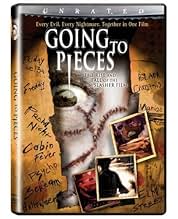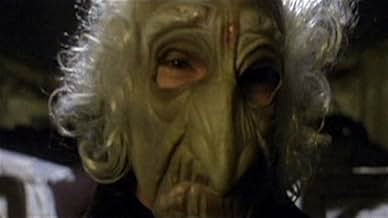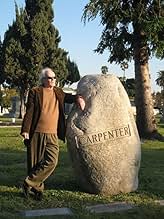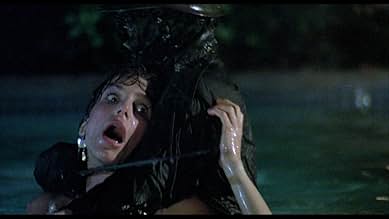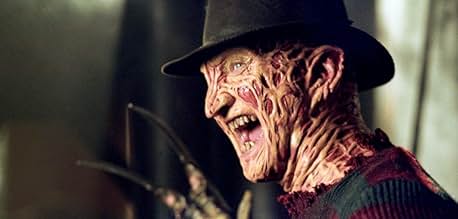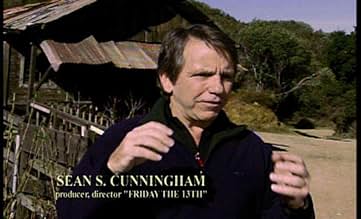AVALIAÇÃO DA IMDb
7,2/10
3,7 mil
SUA AVALIAÇÃO
Adicionar um enredo no seu idiomaA documentary on the history of the slasher film.A documentary on the history of the slasher film.A documentary on the history of the slasher film.
- Direção
- Roteiristas
- Artistas
Amy Holden Jones
- Self
- (as Amy Holden-Jones)
Anthony Timpone
- Self
- (as Tony Timpone)
Avaliações em destaque
10kirk-246
I am probably one of the biggest fans of slasher movies.Whenever I see one,I expect gore,violence,and mayhem.'Going to Pieces: The Rise of the slasher Film' delivers what I want.It shows us when the slasher genre was famous after such films such as 'Psycho', 'Halloween', and 'Scream'.It also shows us when the genre was becoming weak after films such as 'The Texas Chainsaw Massacre: The Next Generation' and many others.What really made the movie good was showing us some clips and death scenes of the films of the slasher genre,which makes this documentary both gory and entertaining.I just have one question before my review ends.
Where is the DVD?
Where is the DVD?
I'm a little impressed. Whether the credit belongs to director Jeff McQueen, producers Rachel Belofsky and Rudy Scalese, or the writers, this is a more meaningful, thoughtful documentary than I supposed it was going to be. I'm not saying that it's perfect, because there are embellishments here and there (music cues, title cards) that are a bit gauche, and the enthusiasm and anecdotes that some interviewees share are a bit much at times. Then again, that enthusiasm really speaks to how much fun everyone had making these movies, the passion they have for the underlying craft, and the thrill of the visceral storytelling. The feature earnestly covers a lot of ground: the violent thrillers from which slashers took influence; the art of illusion behind practical effects like blood and gore; discussion of where slashers fit into society and culture, and how they may or may not reflect that society and culture; the push to make movies that exploited every possible holiday and occasion, and every possible weapon of choice; and more. From producers and directors to effects artists and stars, we're greeted with a slew of interview subjects who offer their own perspective on the genre, with focus primarily on the golden age of the slasher from their inauguration with John Carpenter's 'Halloween' in 1978, to the early and mid 80s when slashers had more or less become the new "it" girl of horror. There is nothing in 'Going to pieces' that's a particular revelation, yet the picture gives welcome, broad perspective - or rather, retrospective - that's more sincere and ruminative than I'd have guessed before I sat to watch.
Some films get more emphasis than others, and not unreasonably; 'Halloween' began it all, 'Friday the 13th' raised the bar with crimson and viscera, and 'A nightmare on Elm Street' took things in a wild new direction. If only in passing, though, this touches upon even more flicks than I've seen, and some I'd never even heard of. Along the way, there's an early spotlight on the conventions that largely define slashers, including settings, protagonists, antagonists, murder weapons, and more - and with this in mind, one place where I think the title falters is in failing to identify how easily the genre became very formulaic, and very stale, very quickly. True, there are still many viewers who flock to slashers for the cavalcade of random violence and death, but I think there came a point where slashers became dull unless there is either some major point of brilliance to help it stand out, or some new twist on the style (e.g., 2015's 'The final girls') that really upended norms. In some measure 'The rise and fall of the slasher film' also raises reasonable questions: of what specifically defines the "slasher"; if every piece mentioned herein really is a slasher or just falls into "horror" generally, or some other subgenre; the extent to which slashers may have had influence elsewhere in horror; and ultimately how accurate the name even is, if slashers continue to be a major force in horror cinema. The documentary really does cover a lot of ground, but it could have broadened its scope even more, and despite the name it's worth observing that there's not so much a central thesis here as an overarching idea of examining the genre.
There are notions touched upon in passing that could have been explored even more deeply: the regressive, conservative values that seemingly inform killers in movies; the triumph of "the final girl" as a representation of feminism; the outdated, harmful language and ideas that "other" and demonize a subset of the population by setting up a particular type of figure as the killer (i.e., lots of ableism, homophobia, and transphobia); and so on. In fairness, to whatever extent 'Going to pieces' could have done more, maybe these were also beyond its purview, for the chief intent here was in a sort of history of the genre (as of 2006), and if imperfectly, I think it does that job very well. Whether one is a fan of slashers, or of documentaries, or just an avid cinephile at large, I think there's much to appreciate here for a lot of folks. All told it may not be something one needs to go out of their way to see, but for something light yet interesting, 'Going to pieces' is a fine movie that's well worth checking out if you have the chance.
Some films get more emphasis than others, and not unreasonably; 'Halloween' began it all, 'Friday the 13th' raised the bar with crimson and viscera, and 'A nightmare on Elm Street' took things in a wild new direction. If only in passing, though, this touches upon even more flicks than I've seen, and some I'd never even heard of. Along the way, there's an early spotlight on the conventions that largely define slashers, including settings, protagonists, antagonists, murder weapons, and more - and with this in mind, one place where I think the title falters is in failing to identify how easily the genre became very formulaic, and very stale, very quickly. True, there are still many viewers who flock to slashers for the cavalcade of random violence and death, but I think there came a point where slashers became dull unless there is either some major point of brilliance to help it stand out, or some new twist on the style (e.g., 2015's 'The final girls') that really upended norms. In some measure 'The rise and fall of the slasher film' also raises reasonable questions: of what specifically defines the "slasher"; if every piece mentioned herein really is a slasher or just falls into "horror" generally, or some other subgenre; the extent to which slashers may have had influence elsewhere in horror; and ultimately how accurate the name even is, if slashers continue to be a major force in horror cinema. The documentary really does cover a lot of ground, but it could have broadened its scope even more, and despite the name it's worth observing that there's not so much a central thesis here as an overarching idea of examining the genre.
There are notions touched upon in passing that could have been explored even more deeply: the regressive, conservative values that seemingly inform killers in movies; the triumph of "the final girl" as a representation of feminism; the outdated, harmful language and ideas that "other" and demonize a subset of the population by setting up a particular type of figure as the killer (i.e., lots of ableism, homophobia, and transphobia); and so on. In fairness, to whatever extent 'Going to pieces' could have done more, maybe these were also beyond its purview, for the chief intent here was in a sort of history of the genre (as of 2006), and if imperfectly, I think it does that job very well. Whether one is a fan of slashers, or of documentaries, or just an avid cinephile at large, I think there's much to appreciate here for a lot of folks. All told it may not be something one needs to go out of their way to see, but for something light yet interesting, 'Going to pieces' is a fine movie that's well worth checking out if you have the chance.
This is an interesting and pretty thorough documentary on the slasher film. It's not as good as reading a book on the subject, of course (there are several now, and this documentary is based on one of the better ones), but you get lots of films clips, and some interviews, not only with the usual horror convention attendees like Tom Savini and Felissa Rose,but also with more obscure characters like the Rabbi Herbert Freed who directed the obscure slasher "Graduation Day" (before he was a rabbi, of course).
What's most interesting for someone like me who is old enough to remember the first wave of slasher movies, is to recall how alarmed adults were at the time by these movies, which look like pretty harmless fun now. I especially remember the way they actually picketed "Silent Night, Deadly Night" because they were upset by the idea of an axe-murdering Santa Claus (in an ideal world these kind of idiots would be met with tear gas and police batons, just like anti-war protesters--who often have a legitimate reason for being upset--often are).
It's also ironic how widely available, thanks to DVD, uncut versions of these movies are today, considering how they were hacked up by American censors back then or outright banned over in Britain. It's probably just as stupid to get worked up about movies like "Hostel" or "Captivity" like people do nowadays. Remember the famous ad-line to "Last House on the Left" (one movie this doc barely mentions, although I guess it isn't really a slasher). "It's only a movie... It's only a movie. . .
What's most interesting for someone like me who is old enough to remember the first wave of slasher movies, is to recall how alarmed adults were at the time by these movies, which look like pretty harmless fun now. I especially remember the way they actually picketed "Silent Night, Deadly Night" because they were upset by the idea of an axe-murdering Santa Claus (in an ideal world these kind of idiots would be met with tear gas and police batons, just like anti-war protesters--who often have a legitimate reason for being upset--often are).
It's also ironic how widely available, thanks to DVD, uncut versions of these movies are today, considering how they were hacked up by American censors back then or outright banned over in Britain. It's probably just as stupid to get worked up about movies like "Hostel" or "Captivity" like people do nowadays. Remember the famous ad-line to "Last House on the Left" (one movie this doc barely mentions, although I guess it isn't really a slasher). "It's only a movie... It's only a movie. . .
I can't even begin to describe my feelings for this extremely informative, and entertaining documentary. Going to Pieces: The Rise and Fall of The Slasher Film is an amazing look at the critically panned, but successful genre of horror, "the slasher genre" to be specific. The slasher genre is probably my second favorite genre, first being the situation dialog world of film. If I become a critic, a dream I hope I will fulfill, I can assure you I will be the only critic who gives a positive review to a slasher film. Remakes will not live by that rule.
The film is mainly about how slashers had their fifteen minutes of fame starting in the late seventies with the film Halloween (of course there were dozens that preceded this, but this was the first that got a lot of recognition. And the first to come to fan's mind when hearing the term). A countless number of slasher followed, but none of which really seemed to catch on, like Don't Go in the Woods Alone and He Knows When You're Alone.
Friday the 13th came out in 1980, and that was the next big horror film that spawned a countless number of sequels. And it became a box office success in no time. The next biggie was A Nightmare on Elm Street in 1984. The slasher that would spawn another line of sequels, and a crossover with F13's Jason Voorhees in 2003.
The one thing about the film is it not only goes into the bigger, more well known icons of the horror genre, but also the smaller ones that were sometimes made by companies that no longer exist now. When Halloween and F13 came out, other companies and sometimes just regular people would go and make a slasher film. Why not? It's cheap entertainment! You don't need a big budget, a whole lot of script, good actors, or even a moral. Just have some traumatized kid grow up to be a traumatized adult that goes around killing everyone for reasons you can't quite explain. I guarantee, it will have a following of some kind.
The film features three of the horror greats that I can't get enough of; John Carpenter, Wes Craven, and Tom Savini. Carpenter is the director of Halloween, Craven is the director of A Nightmare on Elm Street and dozens more cult films, and Tom Savini is the makeup artist on films like The Burning, Friday the 13th, and Maniac. Rob Zombie and others make appearances as well.
The film was made in 2006 I believe, so around that time there weren't a whole lot of remakes out, which I'll be the first to say this ever, was a bit disappointing since I wanted to hear what the directors of the films would say about their films being remade. Most of them poorly. At least we hear a few moments of Zombie explaining his Halloween, but that's about it.
While the movie spits facts like none other, it doesn't really get into the way these films made people feel. In the eighties, people weren't used to these movies, and many were freaked when seeing them in the theaters. I wish they would've shown some footage of people in the theater watching these films, or just the directors talking about the first time they saw a Horror film. That would've made the film a four star film.
My favorite segment hands down was when they discussed Silent Night, Deadly Night's boycotts, and overreactions from uptight parents. Seriously, this movie wasn't in the theaters very long because of parents who didn't know what the form of "dark entertainment" was. Why didn't they boycott a movie that was released four years earlier called Christmas Evil? Nothing pisses me off more than parents that overreact to something, and prevent others from enjoying it.
One lady on this documentary, Felissa Rose I believe, stated that if her daughter saw the trailer to this film she would explain what kind of entertainment there is in the world, and why it's a work of fiction. Not make a damn picket sign, and stand in front of a theater in the subzero weather because you get offended when you see something that is likely to be out of kid's heads come the holiday season.
Aside from simple flaws, Going to Pieces is highly educated and an informative look at a genre that should go anywhere but "to pieces".
Starring: John Carpenter, Wes Craven, Tom Savini, Felissa Rose, Sean S. Cunningham, and Jeff Katz.
The film is mainly about how slashers had their fifteen minutes of fame starting in the late seventies with the film Halloween (of course there were dozens that preceded this, but this was the first that got a lot of recognition. And the first to come to fan's mind when hearing the term). A countless number of slasher followed, but none of which really seemed to catch on, like Don't Go in the Woods Alone and He Knows When You're Alone.
Friday the 13th came out in 1980, and that was the next big horror film that spawned a countless number of sequels. And it became a box office success in no time. The next biggie was A Nightmare on Elm Street in 1984. The slasher that would spawn another line of sequels, and a crossover with F13's Jason Voorhees in 2003.
The one thing about the film is it not only goes into the bigger, more well known icons of the horror genre, but also the smaller ones that were sometimes made by companies that no longer exist now. When Halloween and F13 came out, other companies and sometimes just regular people would go and make a slasher film. Why not? It's cheap entertainment! You don't need a big budget, a whole lot of script, good actors, or even a moral. Just have some traumatized kid grow up to be a traumatized adult that goes around killing everyone for reasons you can't quite explain. I guarantee, it will have a following of some kind.
The film features three of the horror greats that I can't get enough of; John Carpenter, Wes Craven, and Tom Savini. Carpenter is the director of Halloween, Craven is the director of A Nightmare on Elm Street and dozens more cult films, and Tom Savini is the makeup artist on films like The Burning, Friday the 13th, and Maniac. Rob Zombie and others make appearances as well.
The film was made in 2006 I believe, so around that time there weren't a whole lot of remakes out, which I'll be the first to say this ever, was a bit disappointing since I wanted to hear what the directors of the films would say about their films being remade. Most of them poorly. At least we hear a few moments of Zombie explaining his Halloween, but that's about it.
While the movie spits facts like none other, it doesn't really get into the way these films made people feel. In the eighties, people weren't used to these movies, and many were freaked when seeing them in the theaters. I wish they would've shown some footage of people in the theater watching these films, or just the directors talking about the first time they saw a Horror film. That would've made the film a four star film.
My favorite segment hands down was when they discussed Silent Night, Deadly Night's boycotts, and overreactions from uptight parents. Seriously, this movie wasn't in the theaters very long because of parents who didn't know what the form of "dark entertainment" was. Why didn't they boycott a movie that was released four years earlier called Christmas Evil? Nothing pisses me off more than parents that overreact to something, and prevent others from enjoying it.
One lady on this documentary, Felissa Rose I believe, stated that if her daughter saw the trailer to this film she would explain what kind of entertainment there is in the world, and why it's a work of fiction. Not make a damn picket sign, and stand in front of a theater in the subzero weather because you get offended when you see something that is likely to be out of kid's heads come the holiday season.
Aside from simple flaws, Going to Pieces is highly educated and an informative look at a genre that should go anywhere but "to pieces".
Starring: John Carpenter, Wes Craven, Tom Savini, Felissa Rose, Sean S. Cunningham, and Jeff Katz.
GOING TO PIECES is a fun reflection on the slasher genre, primarily exploring the wave of American slasher flicks that came out since the success of Carpenter's HALLOWEEN in 1978. Other influences such as Argento and Bava are only mentioned in passing, and there are some notable omissions (what about BLACK Christmas?) but for the most part this is a fun and in-depth look at a much-maligned sub-genre of film.
Obviously, the documentary is awash with clips that take up about two-thirds of the running time. Most of these focus on the goriest of the kill scenes in each film, so if that's your bag then you'll enjoy yourself. However, in addition, we get interviews with tons of guys involved with the production of these movies; writers, producers, directors, occasionally stars. You'd expect to see Carpenter and Savini here, but I appreciated the less well-known faces too. GOING TO PIECES is a great watch for anyone with even a minor interest in the slasher genre.
Obviously, the documentary is awash with clips that take up about two-thirds of the running time. Most of these focus on the goriest of the kill scenes in each film, so if that's your bag then you'll enjoy yourself. However, in addition, we get interviews with tons of guys involved with the production of these movies; writers, producers, directors, occasionally stars. You'd expect to see Carpenter and Savini here, but I appreciated the less well-known faces too. GOING TO PIECES is a great watch for anyone with even a minor interest in the slasher genre.
Você sabia?
- CuriosidadesExecutive Producer Michael Ruggerio had previously worked on The American Nightmare (2000), one of the documentaries that inspired Going To Pieces. He always said he wanted to do a sequel about the Slasher movies of the 1980's. He happened to be good friends with author Adam Rockoff. After producer Rudy Scalese optioned the book rights to Going to Pieces and befriended Adam Rockoff, Adam made an introduction to Ruggerio who was now an executive at STARZ and championed the documentary to be made.
- Citações
John Carpenter: New talents come along, old talents fade away.
- ConexõesFeatures A Guerra dos Mundos (1953)
Principais escolhas
Faça login para avaliar e ver a lista de recomendações personalizadas
- How long is Going to Pieces: The Rise and Fall of the Slasher Film?Fornecido pela Alexa
Detalhes
- Data de lançamento
- País de origem
- Idioma
- Também conhecido como
- Going to Pieces - el éxito y la caída del cine de destazamiento
- Locações de filme
- Los Angeles, Califórnia, EUA(Hollywood Forever Cemetary)
- Empresas de produção
- Consulte mais créditos da empresa na IMDbPro
Bilheteria
- Orçamento
- US$ 600.000 (estimativa)
Contribua para esta página
Sugerir uma alteração ou adicionar conteúdo ausente

Principal brecha
By what name was Em Pedaços (2006) officially released in Canada in English?
Responda

